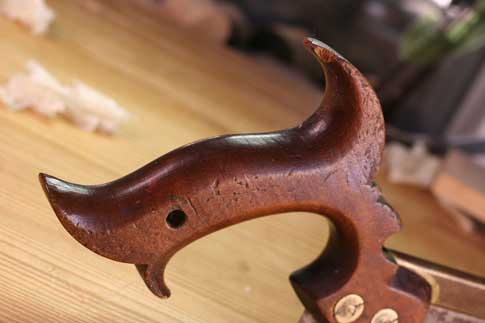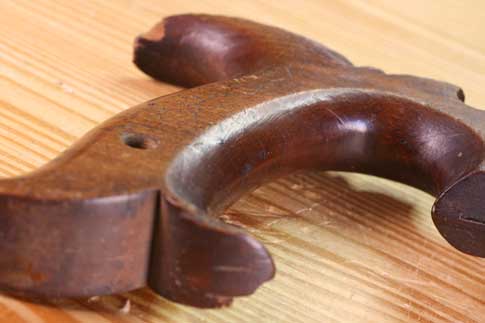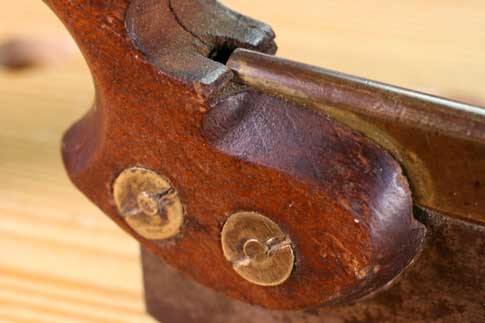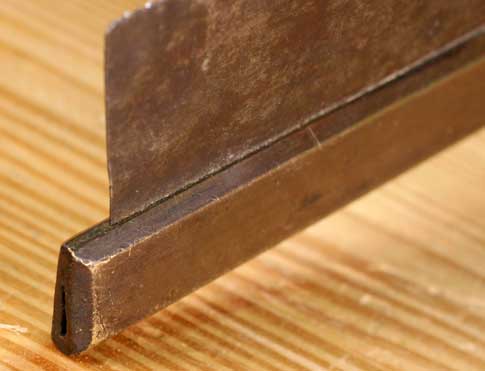This week I had an unusual visitor in the office. Auctioneer Toot Ewalt loaned me the rare 18th-century dovetail saw that he brought to the Woodworking in America conference earlier this month. I had the saw sitting on my desk for 10 days along with all the other dovetail saws we own.
(If you haven’t heard the wild story about this circa 1770 saw made by John Kenyon, check out my blog entry at Woodworking Magazine.)
Between frantic bouts of editing manuscripts for the February 2009 issue of Popular Woodworking I picked up each saw over and over to get a feel for the differences in the handles. After 10 days I concluded that the Kenyon saw was as comfortable as the saw I’ve picked as my daily driver: the Lie-Nielsen Independence dovetail saw.
That’s good news because Mike Wenzloff at Wenzloff & Sons is building a reproduction of this saw. And if a reproduction isn’t good enough for you, then start watching the action catalogs. The saw’s owner says he’s investigating selling the original saw at auction.
If you haven’t noticed by now, saw and handplane handles are important to me. If the tool isn’t comfortable, it will be difficult to use. Now, as woodworkers, we have the tools to make our own handles. But have you ever tried?
I sure have. I’ve made several saw handles and plane totes during the last decade, and I’ve never been happy with my efforts. I’ve also taken a rasp to a few other handles with mixed results. My tendency is to make the curves too pronounced. And to reduce the handle’s width too much.
I’ve found that handles are much like the seat of a Windsor chair. When I make a seat that is really sculpted, it feels good when I first sit in it. But I quickly get tired of sitting in highly sculpted chairs. My most comfortable chairs have shallow saddles. (Correction: My most comfortable chairs have cushions.)
Same goes for handles. The overly sculptural ones aren’t comfortable after I cut a few joints. But dialing in the right amount of shaping has been a challenge for me. Hence, my obsession with finding saws with good stock handles.
However, if you want to try to make your own handle, then download this tracing supplied to Lost Art Press by woodworker William Duffield.
Real Details
The other revelation about the Kenyon saw was its level of fit and finish. It wouldn’t pass muster in a modern shop. Heck, Mike Wenzloff would probably throw this handle on the burn pile. You can still see rasp marks all over the tote that look original (the saw shows no sign of being refinished). The slot for the blade is overcut – a no-no in modern work.
And yet this is the prettiest saw I have ever held. I even like the cringe-inducing hang hole.
My only regret during my 10-day affair with this saw is that I didn’t get to cut a dovetail with its 20 (or perhaps 21) ppi blade. The teeth are in poor shape, the blade has dropped, the handle is loose and the sawplate is significantly bent.
I guess I’m going to have to wait for Wenzloff to finish up his reproductions before I can experience the whole package. He promised that I can borrow one of his Kenyon saws (I thought about buying one, but I need another dovetail saw like I need another smoothing plane). When I get the Wenzloff saw in hand, I’ll file a full report.
— Christopher Schwarz





Chris, I would have to agree. Being patient is not one of my strengths so I went ahead and made a handle by blowing up the original picture of the saw, and then making the reproduction out of Box Wood. It is incredibly comfortable. There was a madness to my method. I am having a local saw maker make me a saw using my handle and to the specifactions from the saw. I can’t wait to get it, I have a bunch of projects coming up and it will get a lot of use.
Take care,
Dan Barrett
Chris,
OK, I’m feeling a little 18th century saw dumb! I have a saw that appears to be almost identical to the one pictured. The rounded off edge around the front of the handle doesn’t go all the way around the edge as this one does, it "peaks" at the blade support. It has the same type handle nuts and "Tillotson Sheffield German Steel" stamped on the blade support. Condition is a lot better than the one pictured but definitely very old and original, and yes, I can spot slight file marks on this handle also. Blade is 10" by 2 1/8" with 15-16 teeth per inch (and cut very uneven)
What are the main differences between 19th and 18th century hand saws? What do you look for?
Most Tillotson saws I’ve seen are 19th century ones. And I don’t have a book "Handsaw Makers of Britain" by Erwin Schaffer and Don McConnell.
http://www.planemaker.com/products.html
That would be able to narrow it down for you as to when it was made.
Also, the "German steel" stamp is a clue. German steel (also called shear steel) was in use in the 18th century and well into the 19th I believe.
A photo would help pin it down. 18th century saws have a different look about them.
Chris
An Antique collection, We need to appreciate the skill and art of the artists who designed these.
Its rare to find that quality in present days.
Jessica